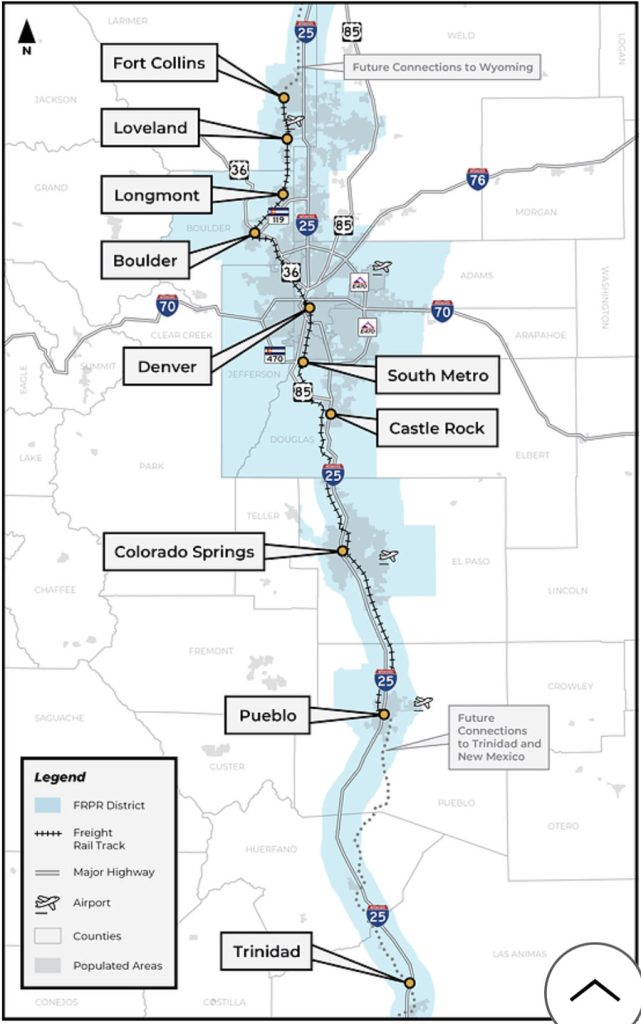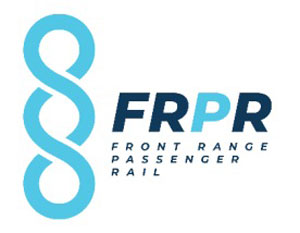Front Range Passenger Rail on track

The FRPR District extends from the Wyoming to New Mexico borders on I-25. The passenger rail is expected to be in operation in 10 years.
 In early December, President Joe Biden announced Colorado’s Front Range Passenger Rail (FRPR) as a designated corridor for federal funding. On December 13, Governor Jared Polis, members of the Front Range Passenger Rail District (FRPRD), along with local and federal leaders attended a virtual meeting with more than 329 attendees to celebrate Colorado’s acceptance into the Corridor Identification and Development Program (ID) and to evaluate what the next steps are.
In early December, President Joe Biden announced Colorado’s Front Range Passenger Rail (FRPR) as a designated corridor for federal funding. On December 13, Governor Jared Polis, members of the Front Range Passenger Rail District (FRPRD), along with local and federal leaders attended a virtual meeting with more than 329 attendees to celebrate Colorado’s acceptance into the Corridor Identification and Development Program (ID) and to evaluate what the next steps are.
“The Biden Administration’s recognition of Colorado as part of the Corridor Identification Program is a very important step to turn all of our hard work and planning into a FRPR that’s convenient, low cost and fast,” stated Polis in a press release.
As communities grow and the estimated population of an additional three million people are expected to live and commute within the Front Range, a transportation solution of a new passenger rail will connect Coloradans to opportunities and adventures. The FRPR aims to improve mobility and multimodal travel options, while connecting communities from Fort Collins through Denver and south to Pueblo.
How is intercity rail service different from commuter rail? Commuter rail, such as RTD, serves one metropolitan area, connecting suburbs to the urban core with stops every two to four miles. Intercity rail complements commuter rail service by connecting cities and regions utilizing existing freight railroad tracks, usually stopping every 20-30 miles.
For more than a decade, Coloradans have supported the notion of a passenger rail service, and in 2021, the state legislature created the FRPRD. With the acceptance into the ID program, the FRPRD will receive a 90/10 match of federal funding to local contribution, resulting in at least $500,000 for the preliminary planning of the passenger rail to begin. Additionally, being ID-accepted puts Colorado ahead of other potential passenger rail corridors in the country.
For the past two years, FRPRD has worked closely with CDOT and the Federal Rail Administration on the Service Development Plan (SDP). The SDP will be available for public review in 2024 and will evaluate potential and future train routes, stations, service, ridership, infrastructure, operations and costs to implement initial train service. Additionally, the FRPRD can levy taxes to fund the rail system by vote and ballot measures.
HNTB vice president Dominic Spaethling, whose firm is the prime consulting agency for the project, said, “Preliminary planning indicates that it is possible for the FRPR to be operating within the decade,” especially given the recent federal funding and if environmental planning goes accordingly.
“We are thrilled to take this major step in bringing a passenger rail service to communities along the Front Range,” concluded FRPRD general manager, Andy Karsian.
To learn more about the FRPR, visit www.ridethefrontrange.com.
By ViVi Somphon; photo courtesy of FRPR